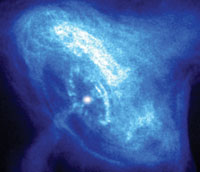The Star Gazer

Christinne Muschi
Award-winning astrophysicist Vicky Kaspi is shedding light on cosmic mysteries and has built an academic program from scratch. Now, if she can only talk her daughter out of wearing the princess costume to school yet again.BY JAMES MARTIN, MLIS’05
It starts simply enough: star runs out of fuel, star implodes. When a really big star collapses, it forms a black hole with a gravitational field so strong that not even light can escape. When a smaller star self-destructs, it creates a neutron star that, in special cases, can be highly magnetized, extremely heavy and fast- rotating. These pulsars (a conflation of “pulsating radio stars”) can rotate more than 716 times per second, emitting electromagnetic radiation in the form of radio waves. Vicky Kaspi calls the waves — audible as a rapid, sharp thrumming — “a heartbeat in the sky.”
In 2000, Vicky Kaspi, BSc’89, left MIT to accept a professorship at McGill, her undergrad alma mater. At the time, she wasn’t just the latest addition to McGill’s astrophysics program, she was McGill’s astrophysics program. The whole thing. Six years later, Kaspi is McGill’s Lorne Trottier Chair in Astrophysics and Cosmology, the Canada Research Chair in Observational Astrophysics and the latest recipient of the prestigious Steacie Prize in the Natural Sciences. Moreover, she now leads a team that has transformed McGill into the country’s locus of high-energy astrophysics research.
In 1967, Cambridge astronomers studying quasars found their data cluttered with regularly patterned radio signals. Initially attributing the pulses to man-made — and, during a brief spell of UFOmania, alien-made — interference, they eventually identified the signals as energy emissions from a new class of stars: pulsars. The same year, Victoria Kaspi was born in Austin, Texas. “Cosmic coincidence?” muses the researcher. “Maybe.”
(Kaspi recently learned that she shares her birthday with an entirely different kind of imploding star. “Anna Nicole Smith was also born in Texas,” Kaspi quips, “and her real name was ‘Vicky.’ Now there’s a coincidence.”)
Vicky Kaspi’s father had a PhD from the University of Texas and taught Hebrew literature. Her mother was an electroencephalogram technician who once worked with legendary McGill neurosurgeon Wilder Penfield; she also wrote humorous essays about family life for the Chicago Daily News. Kaspi was the youngest of the couple’s three children. Her early years were spent in Chicago, then Israel. When Kaspi was five, her mother was diagnosed with a slowly degenerative form of multiple sclerosis; within five years, the disease left her confined to bed. Reflecting on those years, Kaspi simply says, “We had our share of difficulties.”

Kaspi shares her couch and laptop with her children (left to right), Ian, Julia and Hayley
Christinne Muschi
The family settled in Montreal in 1974. Seven-year-old Kaspi regularly, repeatedly lost herself in the pages of Madeleine L’Engle’s A Wrinkle in Time, the story of clever children who embark on a physics-bending quest to rescue their scientist father from an extraterrestrial prison. Later, she graduated to Star Trek. (At MIT, Kaspi started naming her computers after female Trek characters; that well has run dry, so her current rig is dubbed Spock. And, yes, she owns a pair of pointy ears.) She liked mysteries, too, reading Encyclopedia Brown as a kid, Agatha Christie in her teens. “But I guess the space stuff was my favourite,” she recalls. “Anything with a physics flavour.”
In school, she liked all things science and math. Even after suffering through classes with a sexist physics teacher, her enthusiasms didn’t wane. Next to her photo in the Wagar High School yearbook, a teenage Kaspi laid bare her life ambitions: to be a famous scientist, and to have six kids.
Vicky Kaspi and her husband wake up at 6:30, then rouse and dress — or at least attempt to rouse and dress — their three children. Her husband, Dr. David Langleben, MDCM’77, chief of cardiology at the Jewish General Hospital, leaves shortly thereafter to make his 7:30 rounds. The babysitter arrives at seven to give breakfast to Ian (6) and Julia (4). At 7:40, Kaspi shepherds the kids and various backpacks into the carpool. Then she goes jogging for 20 minutes; some days, her jog entails running to and from the grocery store. “I don’t have time to go to the gym, so I try to find ways to sneak in staying in shape,” says Kaspi. “I consider carrying two bags of groceries to be my weight training for the day.” Then it’s time for a quick shower, and breakfast with Hayley (2) before chauffeuring the tyke to preschool. Barring a traffic snarl, Kaspi settles into her office in the Rutherford Physics Building by 9:30.
On her office door, beneath the photo of grinning children and next to the cotton ball snowman, a sticker proclaims, “Go Team Kaspi!”
One of the biggest factors in Kaspi’s decision to return to McGill was the idea of forming a research group from scratch. “When you’re the most recent hire in an established department,” she explains, “the department is already moving in a particular direction. There’s tremendous momentum. The thought of being able to establish something rather than coming in from the bottom and having a tradition existing was very exciting. A very rare opportunity.”
Under Kaspi’s direction, McGill is now at the vanguard of pulsar research. The researchers use earthbound radio telescopes and orbiting X-ray telescopes to harvest the cosmos for massive quantities of data. They then use a Beowulf mini-supercomputer, housed on the third floor of the Rutherford Building, to distinguish a pulsar’s faint radio signal from the relative roar of cosmic noise.
It’s a time-consuming process, the astronomy equivalent of finding needles in haystacks — which makes it all the more incredible that a McGill group, led by Kaspi’s then-postdoctoral researcher Scott Ransom, discovered more than 20 pulsars in the globular cluster known as Terzan 5. Scientists believe that understanding these enigmatic clusters — tightly bound collections of millions of stars orbiting a galaxy’s rotational centre (there are at least 150 clusters in the Milky Way alone) — may unlock crucial insights into the nature of galactic evolution. To understand how a cluster forms, researchers need to understand its pulsar content — and now they’ve got 20 more of the elusive stars to study.
What’s got Kaspi even more excited, though, are the kinds of pulsars formed in Terzan 5 and clusters of its ilk. “They’re very strange,” she says. “By ‘strange,’ I mean pulsars in weird binary orbits — two stars orbiting each other at extremely high speeds — that are impossible to form outside of the cluster.” The unusual physical properties of these pulsar binary systems allow researchers to perform novel tests of general relativity (GR), Einstein’s geometrical theory of gravitation. The theory has only ever been tested in weak fields, yielding non-definitive results that support not only GR, but several alternative gravitational theories; the strong fields of binary pulsars offer a more definitive testing ground for GR’s mettle.
“We’re always glad to find a handful of pulsar binary systems here and there,” she adds, “but to find 20 binaries at once — some of which will be very interesting to study — is very rare.”
Pre-school means half days. Mondays, Wednesdays and Thursdays, Kaspi picks up Hayley at 11:45, drives her home for lunch with the babysitter, and is back at her office for 12:30 — if she’s lucky enough to park her Chevy Venture mini-van close to campus. On Tuesdays and Fridays, Kaspi’s niece, a McGill undergrad, collects the tot. (Except on certain Fridays.) And then there’s Ian and Julia, who have the same drop-off times, but different pick-ups…
“I can’t do it justice with words,” Kaspi admits. “I’d have to show you a chart.”
There really is a chart, too. Kaspi usually keeps the complicated schedule in her head, meting out directives to her network of operatives on a need-to-know basis. But when she’s giving her Steacie Prize Lecture in Ottawa, or attending a NASA colloquium at Alabama’s Marshall Space Flight Center, an intricately detailed chart is necessary for keeping the home fires burning.
“Astrophysics,” says Vicky Kaspi, “is definitely less complicated than handling the day-to-day life of kids. They’re wonderful kids, but persuading my daughter that she does not have to wear the princess costume to school every single day? I find astrophysics much easier.”
Team Kaspi is composed of six grad students, one research assistant, three postdocs and one undergrad researcher. Between seminars, weekly one-on-one discussions with team members (plus a Thursday group pizza meeting) and regular research meetings with colleagues, Kaspi may soon need an intricately detailed chart for her afternoon schedule.
“At least,” she wryly notes, “there’s no driving involved.”
These days, Team Kaspi is particularly interested in magnetars, the very existence of which was long a quarrelsome point in astrophysics circles. Pulsars are powered by rotational energy; other neutron stars are powered by gravitational energy. But some astrophysicists, like Kaspi, speculated that a new class of star may be powered by the decay of ultra-high magnetic fields. When a magnetic field’s strength exceeds 1,014 gauss (G), the quantum theory of electrodynamics kicks in, making it possible to observe a wide array of peculiar behaviour, such as the polarization of vacuums. (To put this force into perspective, NASA speculates that a magnetar could erase a credit card’s magnetic strip from over 160,000 kilometres away.) A magnetar would likely boast a magnetic field of 1,015 G, making it the ultimate field laboratory for watching extreme fundamental physics in action.
Absolute proof of magnetars remains elusive, but Kaspi and her researchers found evidence so compelling that it made true believers of most scientists. For decades, astrophysicists have puzzled over anomalous X-ray pulsars (AXPs), a rare pulsar with no evident energy source. In 2002, Team Kaspi observed X-ray bursts emitting from the AXP known as 1E1048.1-5937. The discovery outs the mystery object as, in all likelihood, a magnetar.
This was huge — “Anomalous X-ray Pulsars Burst Onto the Scene,” trumpeted the cover of Nature — and Kaspi hopes there are plenty more breakthroughs to come.
“These stars do some very bizarre things,” says Kaspi, “and by studying them we can push the frontiers of physics. I feel like if we had only a few more pieces of the puzzle, we could put it all together and really understand them. I’m hoping in the next few years the physics of magnetars will become really clear. When suddenly something has gone from being really confusing to really clear, those moments are really what I love most about my work.
“There have been some areas of neutron star research that I’ve worked on that frankly bored me,” she confesses, “so I moved on. But the work my group is doing on magnetars is extremely exciting.”
The two oldest kids are usually in bed by 7:30 (“Modulo glasses-of-water and there’s-something-scary-under-my-bed-so-come-sit-with-me requests”), with Hayley lingering for an extra 45 minutes. Lunches are made, the newspaper is read. Then Kaspi climbs the stairs to her home office, a spacious (“yet cluttered”) converted attic she shares with her husband.
“Some of my most productive hours are when everyone’s asleep,” says Kaspi, whose work day usually stretches to midnight. “The phone isn’t ringing, the email arrival rate has decreased. I can just do a lot of work that way.”
Her nights are spent poring over her grad students’ analyses of data collected from NASA’s Rossi X-Ray Timing Explorer satellite, writing proposals for viewing time at radio telescopes in Puerto Rico (or West Virginia or Australia or the Netherlands), grading papers…
“There’s no shortage of things to do.”
Before heading to bed, Kaspi leaves a “to be recycled” pile of papers on the kitchen counter. Each morning, four year-old Julia ritualistically roots through the pile, carefully choosing documents according to arcane criteria. She then places the liberated pages into what she calls her “work folder.” Kaspi once snuck a peek, discovering “this bizarre agglomeration of astrophysics manuscripts, cardiology papers, school notices, bits of newspaper and some bills from the grocery store.” Each sheet is covered in Julia’s extensive notation (“not in any recognizable language”) and precisely ordered.
“She sees that we work,” laughs Kaspi, “and this is what work is to her.”

The Crab Nebula pulsar (seen as a bright white dot in the centre of the images above) is located 6,000 light years from Earth and rotates 30 times a second.
NASA/CXC/ASU/J.HESTER ET AL.
Kaspi knows that even the best laid schedules are subject to disruption. Some of these blips, like dentist appointments, are a drag. Others are joyous, like school plays. Or exploding magnetars.
Sometime between breakfast and carpool, 21,000 light years from Earth, 1E 1048.1-5937 went boom. This was excellent news. “We live for these events,” beams Kaspi. “When a magnetar goes off, it’s a big deal.”
Over the better part of the next week, Team Kaspi scrambles to quickly analyze data, alerting the international astronomical community about this time-critical event. They dash off polite requests to briefly borrow various satellites and ground-based telescopes to observe if, and how, the magnetar’s pulse profile and rotation rate changes. It’s a rare opportunity to make observations that will (hopefully) demystify the physics of magnetars. When the urgency settles, Kaspi is exhausted, but elated.
The Steacie Prize is awarded annually to a young scientist or engineer for notable contributions to research in Canada. Kaspi’s win recognizes how her work has radically expanded our understanding of neutron stars, putting her in the elite ranks of Canadian researchers.
The Steacie Prize also puts $15,000 in her pocket. Some of the money financed a party for Kaspi’s research group (“Because they work very hard”), some of it financed the renovation of a third bathroom at her home (because, well, three kids). Kaspi is thinking about using the rest of the money to spruce up the drab hallways of the physics department. She has her eyes on oversized photos of incandescent spiral galaxies and delicately woven supernova tendrils — objects catalogued by the French comet hunter Charles Messier in 1774, yet still boundless sources of astronomical fascination. Decades after last closing A Wrinkle in Time and Encyclopedia Brown Finds the Clues, Vicky Kaspi is still driven by a sense of wonder, still a sucker for a good mystery.
“I guess I find the cosmos comforting in the sense that there are objects out there that are billions of years old,” she offers. “They essentially have always, and will always, exist. They make the difficulties of life seem somehow trivial.”


